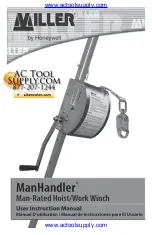
WINCH MANUAL
INTRODUCTION
2
INTRODUCTION
Congratulations on your purchase of a hoist. We design and build hoists
to strict specifications and with proper use and maintenance your hoist
should bring you years of satisfying service.
Every effort has been made to ensure the accuracy and completeness of
the information in this manual at the time of publication, and we reserve
the right to change, alter and/or improve the product and this document
at any time without prior notice.
SAFETY DEFINITIONS
Your hoist can develop tremendous pulling forces and if used unsafely
or improperly could result in property damage, serious injury or death.
Throughout this manual, you will find the following symbols for caution,
warning and danger. Pay particular attention to the notes preceded
by these symbols as they are written for your safety. Ultimately, safe
operation of this device rests with you, the operator.
DANGER
DANGER indicates a hazardous situation which,if not avoided, will
result in death or serious injury.
WARNING
WARNING indicates a hazardous situation which, if not avoided, could
result in death or serious injury.
CAUTION
CAUTION indicates a hazardous situation which, if not avoided, could
result in minor or moderate injury.
NOTICE
NOTICE indicates information considered important, but not hazard-
related (e.g., messages relating to property damage).
GETTING TO KNOW YOUR HOIST
Your hoist is a powerful piece of machinery. It is important that you
understand the basics of its operation and specifications so that
when you need to use it, you can safely use it with confidence. Below
is a list of the components of your hoist and their uses.
NB: A Hoist is not the same as a winch. Hoists are for made
specifically for lifting loads in the air whilst winches are made for
pulling loads horizontally across the ground.
1. Motor: The motor is powered by a 12-volt battery and provides power
to the gear assembly which turns the drum and winds the wire rope
in a direction.
2. Hoist Drum: The hoist drum is the cylinder on which the wire rope is
stored. It can be spooled In or Out by use of the remote lead switch.
3. Hoist Rope: Your hoist been supplied with galvanized aircraft steel
cable and is designed specifically for load capacity of the rated lift of
this hoist. The cable feeds on from underneath the drum position, it
is looped at one end to accept the hook.
4. Gear Assembly System: The reduction gears convert the hoist motor
power into extreme pulling forces.
5. Braking System: Braking action is automatically applied to the hoist
when the hoist motor is stopped or there is a load on the wire rope.
This is achieved by a separate external mechanical brake which
applies the braking action.
6. Solenoid: Power flows through the switch before being directed to
the hoist motor.
7. Wired Remote lead Switch: The remote switch leads have a dual
switch for powering in or powering out your hoist drum. The remote
control allows you to stand clear of the hoist rope when the hoist is
under load.
Summary of Contents for EH800-CAD
Page 24: ...Winch Manual EH800 Exploded Diagram 24 EH800 EXPLODED DIAGRAM...
Page 26: ...Winch Manual EH1000 Exploded Diagram 26 EH1000 EXPLODED DIAGRAM...
Page 28: ...Winch Manual EH1000 SD Exploded Diagram 28 EH1000 SD EXPLODED DIAGRAM...
Page 30: ...Winch Manual EH1200 Exploded Diagram 30 EH1200 EXPLODED DIAGRAM...
Page 32: ...Winch Manual EH1600 Exploded Diagram 32 EH1600 EXPLODED DIAGRAM...
Page 34: ...Winch Manual EH2000 Exploded Diagram 34 EH2000 EXPLODED DIAGRAM...
Page 36: ...Winch Manual EH2500 Exploded Diagram 36 EH2500 EXPLODED DIAGRAM...
Page 38: ...Winch Manual EH3000 Exploded Diagram 38 EH3000 EXPLODED DIAGRAM...
Page 40: ...Winch Manual EH4000 Exploded Diagram 40 EH4000 EXPLODED DIAGRAM...



































